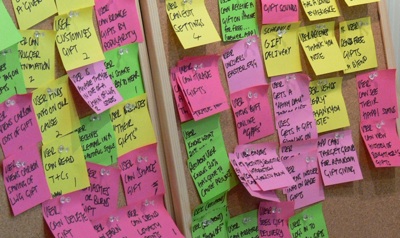Zahmoo for developers
Here at Zahmoo, a theme we’ve been working on a lot over the past few weeks has been around story for software-developers.
Most styles of Agile-development methods such as Scrum, XP and Open Unified Process base their code not on predefined requirements but on evolving ‘user-stories’ – ideally gathered directly from the end-users themselves. Yet what we’ve discovered is that the Agile view of ‘story’ is rather different from the perspective we’ve used in Zahmoo – and we think there’ll be a lot of value in bringing them closer together.
In Agile, a typical ‘user-story’ is a very brief one-line statement, of the form:
- “as a <type of user>, I want <some goal> so that <some reason>“
Sometimes this will be simplified to a form such as “user can <do something> (because <some reason>)” or “something <is done> for user (because <some reason>)”, as can be seen in this prioritised, sorted set of user-stories for a software-project:
So in this kind of software-development, a ‘user-story’ is a small actionable item around which an identifiable and discrete block of code can be written. Anything much larger than this is probably too big to use: it’s often is described as an ‘epic’, and will need to be split into smaller chunks before it can be used.
But in breaking things up in this way – especially down to such a small scale – there’s a real risk of literally losing the plot, losing connection with the larger story. In Zahmoo, as you’ve seen from other posts here, we tend to regard a story as made up of the following components:
- a time;
- a place;
- one or more people;
- a sequence of events; and, usually,
- a ‘why’ or lesson-learned
Or there’s what Anecdote describes as the ‘story spine’:
- Way back when…
- everyday…
- But one day…
- Because of that… and because of that… and because of that…
- until finally…
- so ever since then…
- And [optional] the moral of the story is…
That kind of story keeps us connected to the bigger-picture – and keeps us connected with people, too. But it isn’t actionable in the sense that the software ‘user-story’ would be: to a developer, it’s a ‘epic’ that would need to be split further.
In practice, we need both types of stories: the user’s story, and the much smaller fragments of ‘user-story’. Yet we can store both types of story in Zahmoo, and link them together, via tags, comments and links. That way we gain the best value out of all forms of narrative-work for Agile and the like: the best of both worlds.
So there’s a lot of value there in Zahmoo for software-developers. We’ll explore this theme in more depth over the next few posts.
—-
Image credits: Prioritizing user-stories with our Docs by HGruber under a Creative Commons BY-SA-2.0 licence; Stickies by Katie Lips under a Creative Commons BY-2.0 licence.
Filed in: For Business, For Community
Permalink | Comments Off on Zahmoo for developers


